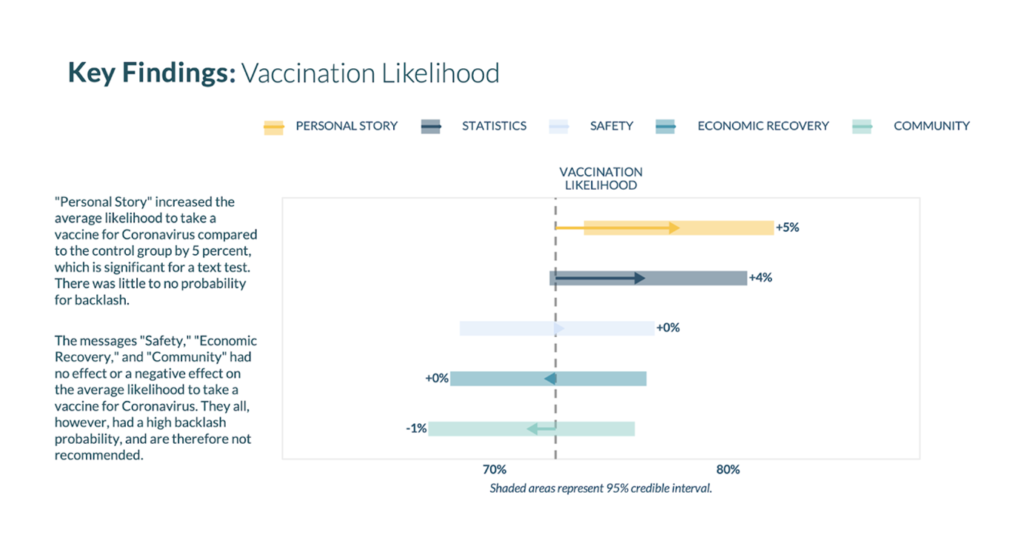We are excited to announce our latest offering — Flexible Cloud Storage — which lets you leverage the full power of Civis Platform, our cutting-edge data science platform, on top of…
There’s a lot of talk about how to talk about the COVID-19 vaccine — how to cut through the rumors, misinformation, and conspiracy theories to persuade people to take the vaccine once it’s available to them. Overwhelmingly, these conversations focus on recommendations and best practices for engaging the target audience, whether it’s “Get your organization’s leadership to talk about it” or “Get a healthcare official to be the messenger.” These are strategies based largely on past public health messaging experiences or, in some cases, old-school intuition and educated guessing.
It’s time to tune out these conversations. None of them address what’s truly important: Optimizing message content and substance to drive widespread COVID-19 vaccination acceptance and adoption — i.e., following a data-driven approach grounded in online message testing, not gut instinct, to pinpoint which ads resonate most deeply with target audiences.
Both the COVID-19 pandemic and the COVID-19 vaccine rollout are unprecedented in shape and scope; COVID-19 vaccine messaging can’t adhere to precedent, either. With so many Americans expressing concerns over the efficacy of the vaccine, public health officials, their creative agency partners, and other stakeholders cannot rely on the same approaches they’ve used in the past to convince the public to, for example, receive their annual flu shots.
At Civis Analytics, we’ve done a lot of public opinion research and message testing illuminating how to talk about public health measures, including the COVID-19 vaccine, in a way that is clearer, more concise, and ultimately more convincing. Our methods are rooted in scientifically validated data insights, not past experience or conventional wisdom.
Our COVID-19 messaging efforts in partnership with the State of Illinois are bearing fruit. In September 2020, 33 percent of Illinois residents said they would be very likely to get a COVID-19 vaccine once it became available to them; by December 2020, that number increased to 40 percent. (As a point of comparison, we saw vaccine intent go up about 5 percent on a national level over the same time period.) Here are five fundamental lessons we’ve learned in the course of our research:
1. Trying to correct misinformation directly via messaging is not effective, and may even result in backlash. It’s essential to present people with the right information about the COVID-19 vaccine without making direct references to correcting misinformation, so keep your messaging simple and direct. Earlier Civis research determined that personal stories are a particularly powerful method of vaccine communication: Messages sharing the story of a young, otherwise healthy American who died from COVID-19 resulted in a 5 percent increase in the number of U.S. adults likely to get vaccinated.
2. De-couple the message that the vaccine is safe from the message that the vaccine is effective. Leading with messages that describe the vaccine as effective can be a winning strategy for some populations. According to our research, leading with messages that assuage safety concerns is ineffective at best, and at worst can make people less likely to get vaccinated. Previous Civis research into HPV vaccine messaging found that discussing vaccine safety was not the right strategy in that scenario, either, despite survey respondents citing safety as their greatest concern regarding HPV treatment — results that underline message testing’s critical importance in delivering the right message to the right audience.

Vaccine safety is not the elephant in the room, however. People have many questions about safety, and those questions should be answered; from a legal and transparency perspective, campaigns must include safety information. But if you talk about effectiveness, keep it independent from your messages about safety — otherwise you could be offsetting your gains in persuasion by reintroducing hesitation.
3. There is a high degree of trust in medical professionals and scientists overall, but this trust is not evenly spread. People who are already likely to get vaccinated have the highest degree of trust in these types of conventional messengers. Others who are more skeptical — the precise group it is most important to persuade — are less convinced by experts and more open to hearing from everyday people who have battled COVID-19 themselves.
Be especially cautious about making mention of agencies such as the FDA or CDC, because there is tremendous public distrust in the federal government. In December 2020, we posed two variations of a question asking people if they were willing to get vaccinated: In response to the version stating the vaccine would be “FDA-authorized,” we saw a statistically significant 7 percent decrease in the number of people who said they would get the vaccine if it were available to them today.
We also found:
a. Eighty percent of people who are “Likely Takers” say that doctors are their most trusted source of information about COVID-19, compared to 63 percent of people who are on the fence about the vaccine (a group we refer to as the “Movable Middle”).
b. Similarly, 80 percent of Likely Takers trust public health experts, compared to 59 percent of the Movable Middle.
c. People who have experienced COVID-19 firsthand are trusted equally by Likely Takers and the Movable Middle (46 percent for the former group, 49 percent for the latter).
4. Repeat message testing over time is essential. COVID-19 information (as well as misinformation) disseminates quickly, and public opinion is in constant flux. Messaging must keep pace; testing against specific audiences and messengers is also important, all of which makes Civis’s creative testing solution essential to delivering the right message to the right audience at the right time.
Consider our partnership with the State of Illinois on its It Only Works If You Wear It mask adoption campaign, designed to respond to the on-the-ground situation in all 102 Illinois counties. Each week, Civis assembles the latest county-level COVID data, which Governor J.B. Pritzker’s team uses to identify and triage areas at the highest risk. Digital media budgets are then shifted to prioritize those at-risk counties, with message testing determining the best method of reminding residents to observe stay-at-home orders whenever possible and to wear masks outdoors to halt COVID-19’s continued spread.
5. Messaging that has been objectively tested to be effective is critical. But messaging is just one piece of a successful COVID-19 vaccination program. We’re encouraged to see that different messages can have an effect on driving intent. However, it would be naive to think that messaging alone can motivate people to overcome the practical challenges of navigating the labyrinth of vaccination prioritization rules (and, if they qualify, knowing where to go to get vaccinated, not to mention taking time off from work, school, or family obligations).
Getting these logistical details right, and making the process easy and convenient, may be the key to boosting vaccination rates for Black Americans in particular. Over 50 percent of Black Americans we surveyed said that the convenience of taking the vaccine near their home or workplace was a very important factor in deciding whether to get vaccinated. Black Americans ranked other factors (risks, effectiveness, whether their family or friends decided to get vaccinated, or whether their doctor recommended it) similar in importance as other groups surveyed.
COVID-19 falsehoods, rumors, and conspiracy theories aren’t going away. But those in positions of power and influence can change the narrative by embracing science in all phases of the battle against the virus — and that includes vaccine messaging.
Want to learn more or explore how these strategies can upgrade your messaging efforts? Contact me at cson@civisanalytics.com.

